 has been studying – his life and his writings. So when we were offered a week time share exchange, at the Carpediem Assisi Living Club, just a few miles outside the medieval city walls, we jumped at the opportunity. From this central location, we could travel to places in Umbria and Tuscany to visit some of the places which pilgrims go ‘in search of St Francis.’ After landing at the Leonardo da Vinci airport in Rome in the early morning, we rented a small Chevrolet Matiz from Europcar, costing SGD$33 per day. As we entered the southern part of Umbria, the hill city of Amelia, we decided to break journey as this was half way between Rome and Assisi.
has been studying – his life and his writings. So when we were offered a week time share exchange, at the Carpediem Assisi Living Club, just a few miles outside the medieval city walls, we jumped at the opportunity. From this central location, we could travel to places in Umbria and Tuscany to visit some of the places which pilgrims go ‘in search of St Francis.’ After landing at the Leonardo da Vinci airport in Rome in the early morning, we rented a small Chevrolet Matiz from Europcar, costing SGD$33 per day. As we entered the southern part of Umbria, the hill city of Amelia, we decided to break journey as this was half way between Rome and Assisi. 9, 10 and 14 Sep 2007. Assisi nestles on the slope of Mount Subasio, made famous by its favourite son St Francis. It is a walled city within which are narrow lanes lined by souvenir shops. There are 8 city gates and on the first day we entered via the Porta Nuova. Within its 5 km fortress confines are more than 10 churches mostly attributed to the early founding fathers of the Franciscan order. Assisi is a place of pilgrimage for many a pious Catholics from Italy and around the world. They arrive to pay homage to their hero, St Francis.
The Basilica of St Francis built in 1228, just 2 years after the death of the saint, dominates the skyline. Clearly the largest church complex, it houses the cloister of a Franciscan monastery, a lower and upper sanctuary and a museum of church artifacts. The basilica is built using the local white stones from Mt Subasio itself, as it was for all the buildings within the walls of Assisi. It is prominent for miles around and in the evening sun it glows with a slight red tinge.
The Basilica is a monument to the saint and it houses his tomb as well
 as his famous disciples, Rufino, Leo, Angelo and Masseo. Before Francis died he confided, “I have done my part; may Christ teach you yours.” Crossing the threshold into the church one cannot help but feel that it was a celebration of the life of one man, its patron saint. Inside, the walls are adorned with frescoes from the 13th Century Italian artists. The most famous being Giotto's panels depicting St Francis' life events along both side walls. Pat remarked that it seems that Jesus Christ has been crowded out in this place of worship by St Francis. Perhaps we are handicap by not being able to understand Italian. Certainly on that Sunday morning the mass continued on even as streams of tourists move past. There were friars, priests and nuns from everywhere. Prominent by their presence were the nuns of the Sisters of Mercy in their grey and blue habit, followers of Christ led by a more modern days saint, Mother Teresa.
as his famous disciples, Rufino, Leo, Angelo and Masseo. Before Francis died he confided, “I have done my part; may Christ teach you yours.” Crossing the threshold into the church one cannot help but feel that it was a celebration of the life of one man, its patron saint. Inside, the walls are adorned with frescoes from the 13th Century Italian artists. The most famous being Giotto's panels depicting St Francis' life events along both side walls. Pat remarked that it seems that Jesus Christ has been crowded out in this place of worship by St Francis. Perhaps we are handicap by not being able to understand Italian. Certainly on that Sunday morning the mass continued on even as streams of tourists move past. There were friars, priests and nuns from everywhere. Prominent by their presence were the nuns of the Sisters of Mercy in their grey and blue habit, followers of Christ led by a more modern days saint, Mother Teresa.The streets of Assisi are always active with tourists busy buying gifts. Within the walls the medieval architecture makes one feel that a time tunnel is accessed as we enter through any of its gates. We were told that not much has changed since the time of St Francis is the 13the century. In the city centre, there is a building the Minerva which was a Roman temple now converted into a church.
A little way downhill through alley ways of shops is the church dedicated to St Clare, the Santa Chiara. It was built in 1257 in Italian Gothic style over the site of the former church of St George, much beloved by St Claire. Prominent in the facade at the second level is a Rosette window. The piazza in front of the church is a large area for congregating. Over the sides of the parapet one gets a full view of the Umbrian valley and plains. Claire was a soul mate of Francis. As a young woman she renounced the world to follow Francis. It is said that she cut off her flowing locks of hair after which she retired to the Church of San Damiano where she remained from 1211 to 1253 when she died. St Clare is entombed in San Chiara, her mummified body clothed in nun's habit lies there peacefully. Her face and feet which are exposed probably covered with a mask or heavily wax because the skin looked very smooth. “Ever since I have known the grace of the Lord Jesus Christ, no suffering has been bothersome, no penance too severe, no infirmity has been hard.” St Claire 1193 -1253.
The church of San Damiano is set in an olive grove. This is where Clare and her new found convent of the sisters of the Poor Clares lived. They had retired there living an ascetic life under the rule established by Francis. This was also the place where Francis retired to and was cared by Claire during his illness before he died. As we approached the church there was bronze statue of someone in a Franciscan habit seated cross legged with hands folded gently on his lap and gazing contemplatively at the olive groves in the distant valley. It was at this place perhaps while gazing at the sunset that St Francis wrote the “Canticle to the Creatures.” He must have witnessed many a sunrise and sunset at the olive groves of the Spoleto valley.
 Porziuncola Chapel ( or Little Portion ) was the early site for Francis' ministry. It was there where he died. It was the headquarters and congregating venue of the Friar's Minor. Today the church of Santa Maria degli Angeli is built over the tiny chapel. This chapel was the meeting place of the Friars when they returned from their witnessing journeys to share stories and encourage one another; It became the early venue for the “chapters” a kind of conference of the growing number of Friar Minors.
Porziuncola Chapel ( or Little Portion ) was the early site for Francis' ministry. It was there where he died. It was the headquarters and congregating venue of the Friar's Minor. Today the church of Santa Maria degli Angeli is built over the tiny chapel. This chapel was the meeting place of the Friars when they returned from their witnessing journeys to share stories and encourage one another; It became the early venue for the “chapters” a kind of conference of the growing number of Friar Minors. Similarly the church at Rivotorto was built over the original hut near
.jpg) the stream where Francis and his companion formed the Friar Minors. At this site, his companions saw a vision of Francis in a flaming chariot at the time he was preaching at an Assisi cathedral. This site has since been termed Sagro Tugurio, marking the cradle of the Franciscan movement.
the stream where Francis and his companion formed the Friar Minors. At this site, his companions saw a vision of Francis in a flaming chariot at the time he was preaching at an Assisi cathedral. This site has since been termed Sagro Tugurio, marking the cradle of the Franciscan movement.The slope of Mount Subasio is a place for retreat and prayer as we discovered when we visited Eremo delle Carceri. This place is about 5 km up the slope from Assisi. The hermitage is shaded by the slope of the mountain and the foliage of the dense vegetation that line the footpath. The term 'Carceri' means retreat and hermitage. Along the footpaths one would chance upon several grottos, whose interior would be very cool making a secluded and serene atmosphere for contemplation. The Franciscan retreat area at Carceri is set over one of the grottoes which Francis used. There he was able to converse with nature something not entirely surprising if one had the opportunity, as we did in the morning of 10 Sep 2007, to walk silently through the shaded paths in autumn.
La Verna 14 SEP 07 Today we drove about 80 km, the last
.jpg) 15 km of which were winding roads to the Franciscan retreat of La Verna. We could not have missed this place because this was where a dramatic event took place in the life of the saint. In the fervour of spiritual ecstasy he bore the wounds of Christ at Calvary, the stigmata. Francis was sick by then. He had given up the official leadership of the movement that he had started and spent more time in prayer and contemplation. It was on September morning in 1224, 783 years ago when the event occurred.
15 km of which were winding roads to the Franciscan retreat of La Verna. We could not have missed this place because this was where a dramatic event took place in the life of the saint. In the fervour of spiritual ecstasy he bore the wounds of Christ at Calvary, the stigmata. Francis was sick by then. He had given up the official leadership of the movement that he had started and spent more time in prayer and contemplation. It was on September morning in 1224, 783 years ago when the event occurred. La Verna was a mountain that an Italian aristocrat gave to Francis as a place for retreat of his growing band of brothers. This mountain top retreat was very cool at the time of our visit and we walked on paths shaded by the canopy of trees. For the first time we could hear the birds singing. We walked to the church built over the site of the stigmata occurrence.
It was built around and over several grottos, many of which are now chapels built along the church perimeter. We entered one of the grottos and immediately felt the coolness and silence of the atmosphere. Sitting on the stone slabs, it felt cool making the small caves a good place for contemplation and retirement. The church is a celebration of the stigmata experience. Apparently at such events, the saint becomes so identified with the passion and suffering of Christ, that he miraculously suffers the same wounds, of nails driven into the palms and feet and the lance pierced on the right side just below the ribs. Apparently the records indicated that up to his death these wounds remained open and needed to be dressed daily. It was also recorded that on that fateful night, the sky became brilliantly lit. A Seraph was said to have appeared and communed with St Francis. For Francis it was a culmination of a lifetime of ascetical discipline. He was able to converse with angels. Inside the sanctuary, there is a display of several memorabilia of St Francis, his plate, his drinking cup, his walking stick and the ash cloth garment that he wore when he received the stigmata.
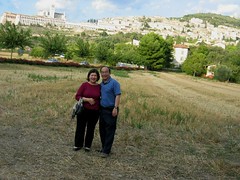


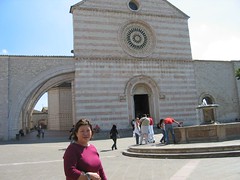
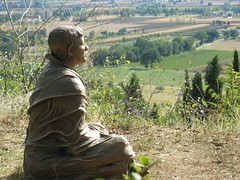

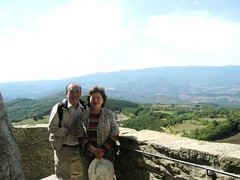
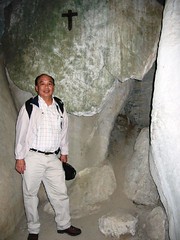
No comments:
Post a Comment